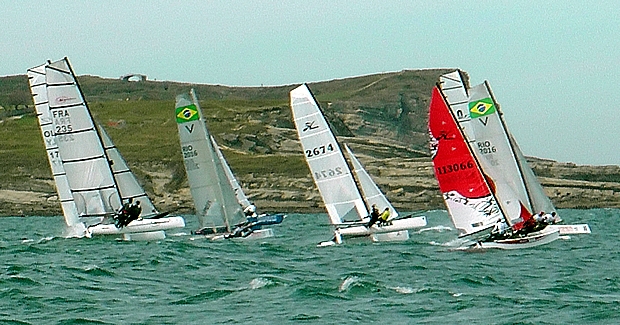
Rio 2016 Equipment trials: The mixed catamarans
Following one of the most terrible decisions made by the ISAF Council to remove the catamaran from the Olympic roster for this year’s Games, so the catamaran is to make a welcome reappearance for Rio 2016, but this time with a mixed crew.
A considerable amount of mixed sailing does take place in catamarans – in fact a lot more than we first thought, particularly in the Hobie 16, the F16 and the F18 classes.
But while a catamaran in the Games is certainly better than no catamaran and we like the egalitarian nature of what a mixed crew represents, we’re not convinced that it will prove a success in the Olympic Games. In fact most competitors we have polled who have been to the Games previously in the Tornado would prefer it to be a single-sex boat, or ideally two classes for men and women, for we suspect in years to come the mixed crew multihull will be dubbed ‘the marriage breaker’.
As multihull designer Yves Loday, the Tornado gold medallist from the Barcelona Games in 1992, pointed out to us: “One guy who is just married - there is no way that his wife will let him spend 100 days a year with another woman!”
In terms of the equipment there have been some key stipulations laid down by ISAF. These include:
- the sailors combined weight will be within the 120-140 kg range
- Sloop rig with an asymmetrical spinnaker
- FRP construction of hulls
- Two part mast
- Twin trapeze
- Unsinkable when holed or swamped with approximately level floatation.
- Able to be shipped in a 6.1m (20ft) container
- Trailerable maximum width 2.59m (8ft 6in)
- Racing is expected to be held in winds in the range 5 to 25 knots
The idea behind the 20ft container and two part mast is that it allows emerging nations, who are unlikely to be shipping an armada of boats and RIBs around the world, to carry out their shipping in a cost-effective manner.
Last week at the ISAF Evaluation Trials in Santander, Spain, seven catamarans were put through their paces by a roster of sailors put forward by Member National Authorities.
Surprisingly, considering the different shapes and sizes on trial for the Women’s Two Person skiff slot, with the exception of the Tornado and the Hobie 16 at the top and bottom ends, there was a lot less to choose between the design of the remaining boats. While hulls shapes, in particularly bows vary, now standard are the two alloy beams fitting into recesses in the hulls, kick up rudders, rotating carbon fibre or alloy wing masts, a bowsprit with kite retracting into a large sock, a self tacking jib, daggerboards (rather than the Tornado’s centreboards), etc etc.
| Multihulls | Hobie 16 | Hobie Tiger F18 | Nacra 16 | Nacra 17 | Spitfire S | Tornado | Viper |
| LOA | 5.05 | 5.48 | 5 | 5.2 | 5 | 6.09 | 5 |
| Beam | 2.41 | 2.59 | 2.5 | 2.44 | 2.52 | 3.08 | 2.5 |
| Weight | 145 | 180 | 129 | 142 | 139 | 165 | 129 |
| Sail area main | 14 | 17 | 15 | 15.25 | 15.75 | 15 | 15 |
| Sail area jib | 5.77 | 3.45 | 3.7 | 3.81 | 4.2 | 8 | 3.7 |
| Sail area spi | 14 | 19 | 17.5 | 17-19 | 19 | 25 | 17.5 |
| Price | 12,000 € | 15,700 € | 13500€ exvat | 19500€ carbon mast, 16500€ alloy mast | 25,900/15,900€ | 16000€ inc VAT | |
| Designer | Hobie Alter Snr | Hobie Cat | Morrelli/Melvin | Morrelli/Melvin | Yves Loday | Rodney March | Greg Goodall |
| Builder | Hobie Cat | Hobie Cat | Nacra Sailing Int | Nacra Sailing Int | Loday White | Various | AHPC |
| First boat launched | 1972 | 1996 | 2011 | 2012 | 2002/2010 | 1967 | 2009 |
| Crew weight | 130-135 | 110-130 | 120-140 | 135kg | 120-170 | 125-145 |
Tornado
One of the most vocal advocates of returning the multihull to the Olympic Games, is Germany’s Roland Gaebler, a three time Tornado World Champion when the boat was Olympic, who also won the bronze medal in Sydney in 2000. In recent years Gaebler, now President of the Tornado Class Association, has been sailing with wife Nahid and together they won the 2010 Tornado World Championship.
The Rodney March-designed Tornado of course is the original Olympic catamaran first introduced to the Games for Montreal in 1976 but ejected following Beijing. It received an overhaul after the Sydney Games when a new carbon rig was added along with a kite and a second trapeze.
While Gaebler was pleased that a multihull was back in the Games, he has been gunning hard for it to be the Tornado, and was not best pleased (to put it mildly) when ISAF stipulated that the new multihull would have to fit into a 20ft container and therefore have a two piece mast. However they have managed it, as Gaebler explains: “I realised that we could do it – we can fit it into a 20ft container and have a two piece mast. Also the weight range - we have some teams which are under 140kg so we can match every point. And we have some points that the others don’t have – we have the Worldwide Class Association, we have a secondhand boat market, so the whole mixed sailing can start immediately...”
In fact none of the cats in Santander, except the one specifically built for the trials, comes with a two part mast as standard, although once upon a time the Hobie 16’s was manufactured this way. In Santander all the boats had been especially fitted with two-part masts, some such as the Viper and Nacra’s offering both carbon and alloy options for trial.
“We can make it, but we think it is wrong because a two piece mast will never have the same characteristics as a one piece mast,” says Gaebler. “Goran [Marstrom – the top Tornado builder] was telling me that if we do a two piece mast, the junction - because you put it on and take it off a lot - over time it will get more easy and you can play with it. I sailed a Laser for six years and I knew that if you joined the mast and twist it, you can always play with it a bit. So the mast will be less one design... But we have tried it and that’s it.”
Given the Tornado is 20ft long, fitting it into a container of the same length has even been managed, by fitting it on a special rack with the stern up in the air.
Perhaps most significant about the proposal to ISAF from the Tornado class is that they are offering it to be supplied equipment for not just the Games but for the Sailing World Cup and World Championships.
A favourite point of Gaebler’s is that although the cost of the hardware is initially high, the Tornado has longevity and better built ones won’t go soft. Famously Roman Hagara raced the same boat in three Olympiads winning gold in two of them. So it is still possible to buy a secondhand Marstrom boat for 5-6,000 Euros, repaint it and put new fittings on it and to be sailing a boat that is almost as good as new for around 8,000 Euros.
However today the new price of Tornados has come down. At present two options are being offered by the class – the Marstrom-built boats are state of the art with hulls made from prepreg with a Nomex honeycomb core and put together in an autoclave. These cost 25,900 Euros. But there is a Polish-built alternative constructed with a more conventional epoxy/glass/foam manner, called the Exploder Tornado which costs just 15,900 Euros, still with a carbon mast. Gaebler had both examples in Santander.
Since Beijing the class has also been attempting to make the Tornado more one design. For example one design sails now come from Ullman, who have previously designed the wardrobes for Olympic Gold medal and World Championship winning Tornados. The sails have also been tweaked to make them more appropriate for a mixed crew, with the genniker becoming a little smaller and the white sails getting flatter. “Or aim was to make it for the average of mixed teams, which is 140kg worldwide – we made analytics of this,” says Gaebler.
He adds that he has also come up with a plan for a one design trampoline and fittings. “So we are coming very close to a complete one design.” However they will probably leave the mainsheet open if people want to have a purchase system of different power.
Back to crew weight and he and wife Nahid currently weigh in at 155kg combined (ie over the ISAF limit), which Gaebler admits is more than his usual fighting weight. However the analytics he has carried out into combined crew weights in both the Tornado and other catamaran classes indicates than typically 80% of mixed crews are above the ISAF instigated upper limit of 140kg.
“With a flexible rig, we tried to have it so that teams of 120-170kg can trim the boat. At the last World Championship our lightest crew was 126kg ,but they were still winning races in up to 30 knots.”
He concludes: “We think the Tornado – it is the very top and it is a sporting challenge and we think it is still the fastest. We are quite surprised that some more modern designs are slower than the Tornado.”
Gaebler is also campaigning that along with the Tornado being chosen for the Games, ISAF also choose to further what they are already doing with the medal race and have stadium-racing courses close into the shore for the Tornado, to maximise spectator appeal.
Viper
Production from Australian High Performance Catamarans has shot up since partners Darren Bundock and Carolijn Brouwer and their company 2B Sailing became European importers two years ago. They market the C2 F18– see Darren Bundock’s video guided tour to this here – and also the smaller Viper F16, which was present in Santander last week with Brouwer, the last woman to campaign a Tornado at the Olympic Games, at the helm.
Greg Goodall and son Bret’s company AHPC operates out of Bendigo, which while it is out of the way, located around 130km north of Melbourne, has become something of a multihull hub in Australia, also home to Glenn Ashby the A-Cat wizard and his sailmaking business.
Technically the Viper is a F16, the new class on the rise and smaller brother to the F18. The Viper is deliberately heavier than the F16’s class’ minimum weight and with 200 units sold since it went into production in 2010, typically it races as a class within a class.
“The reason why Greg designed the Viper was because a lot of the teams in the F18 were struggling to be competitive in the 150+kg weight range, so he decided to design a boat that was just under that,” explains Brouwer. “I think the main feature for me on the boat is the rig – it is a really powerful, versatile rig which makes it critical but it allows for a large weight range.”
For the Viper, Brouwer reckons the ideal crew weight range is 125-145kg. “I sailed with Liz Wardley at 118kg [combined weight]– I am only 62kg and she is less and she doesn’t have the leverage either...but it was not a problem. We can make it around the course, but that is mainly due to our technique and our experience cat sailing but speed wise with 118kg you do struggle. They [heavier crews] munch us down upwind, but downwind and in the light we are a weapon. I have done races with Lizzie in 25-28 knots and it hasn’t been a problem.”
However she points out that rather more burly Greg Goodall has raced with a girl crewing for him at 146kg combined weight and they had no problem either. “And they were quick in the light, so there is something about the rig on the Viper which makes it really versatile,” says Brouwer.
At the F16 Worlds, Vipers finished in all of the top seven spots while eight were in the top 10. The average weight of those crews was 138kg. “So we were in the upper range of the weight [ISAF’s 120-140kg]. I was with a guy and we came under that, but we still finished fourth, so still up in the top bunch.”
The shape of the bows of the Viper is unusual – quasi-wave piercing with its buoyancy highest at the waterline and getting finer higher up. A nice feature of the boat is that the control line for the all-important Cunningham runs under the trampoline and then out to the trapeze.
The other plus point of the Viper, Brouwer points out is its manoeuvrability. “Because of its light weight the manoeuvrability is really good, so it makes it really quick to tack and gybe which makes the boat more tactical. One of our young guys, Jason Waterhouse, who has been the ISAF Youth World Champion, that is what he likes about the Viper, because he says it is such tactically intense racing. Against the bigger boats - they have to pick a corner, and you are smaller on not a very manoeuvrable boat, you just sit in their bad air, whereas we can tack away and tack back, like a dinghy. So I believe we could have more tactical racing in the Viper. Also we have seen it behaves really well in choppy conditions.”
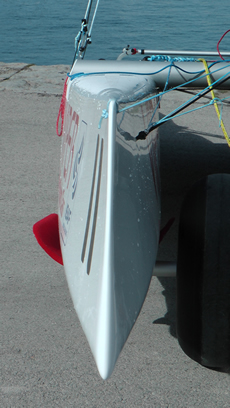 |
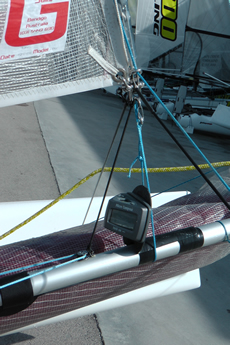 |
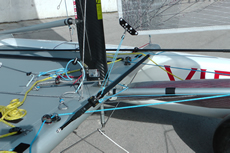 |
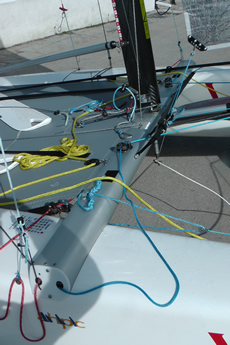 |
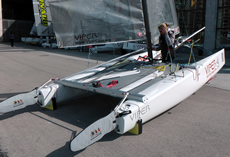 |
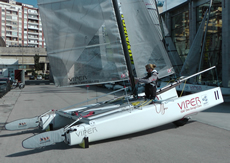 |
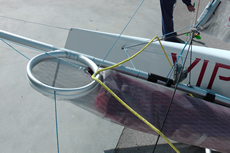 |
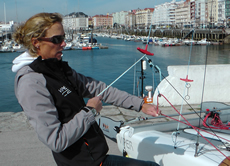 |
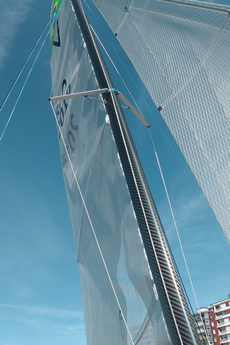 |
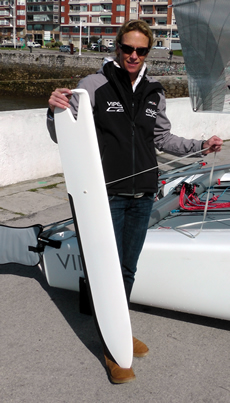 |
Hobie 16 and Tiger F18
Both Hobie and NACRA were in Santander with two models, in Hobie’s case their 16 and F18 Tiger.
With its characteristic banana-shaped daggerboard-free hulls slung under a rectangular platform and trampoline, the Hobie 16 is one of the most prolific boats the sailing world has ever seen with production numbers believed to be approaching 100,000 units since it was launched in 1972. In this respect it is only thought to be outstripped by the Sunfish and the Laser. “It is more than 50,000 because in 1980 were building around 1,000 per month around the world. It could be 100,000 boats, but 50,000 boats are active for sure,” says Michel Corigliano, who has been Project Manager for Hobie’s Olympic equipment bid and who is also in charge of the Marketing for Europe, the Middle East and Africa.
Aside from fitting both models with two piece masts neither boats had been modified for the trials. According to Coriglino, they offered these two boats up for the evaluation because they are already widely sailed by mixed crews and were the most appropriate in Hobie’s range – they could have brought their new F18 model for example, the Wildcat.
“We brought the Tiger rather than the Wildcat because it is a more appropriate boat for a mixed crew and around the world there are a lot of Tigers available,” says Carigliano. “We’ve built around 2,000 and it is good to start an activity like this with a big secondhand market.”
With the 16, typically they are still getting 150 boats at European championships and within this a substantial percentage of crews are mixed. Under class rules there is a minimum crew weight limit of 129kg and Corigliano says that average crew eight is typically 130-135kg.
At present Hobie has three factories around the world – in France, the USA and Australia - building their boats, although the company itself is now divided in two with the European and US operations separate.
Spitfire S
While the majority of the Women’s skiff offerings at the trials were from the UK, the only British-built mixed cat in Santander was the Spitfire S and even she has a French designer.
Although well known for his Tornado gold medal, Yves Loday is also one of the most prolific dinghy cat designers with 15 of his boats still in production either via Loday White or his own company in France, Sirena Voile. The line includes many smaller models that are popular with families and youth sailors.
The Spitfire S is effectively the Mk2 version of the boat originally launched 10 years ago following Loday’s experience with the Dart 16 and the SL16. The original version of the Spitfire has been used by the youth catamaran squad in the UK, while the SL16 is the multihull used at the ISAF Youth Sailing World Championship.
The change to the S version isn’t so much of a turboing of the boat as a reworking – the mount for the aft cross beam has been raised so it is higher off the water and the sails have been modified, while some of the additional gear has been modified to make rigging and de-rigging faster.
“The structure of the boat has been very well proved,” says Loday. “At the last British Nationals no29 came sixth, so it is proof of the boat’s quality.”
Around 235 Spitfires have been built to date, and Loday says that mixed crews are in the vast majority. He reckons average crew weight it around 135kg, but once again there are a number of options, such as batten stiffness that can be used to adapt the rig to different weight ranges.
“We have some crew at 115kg and they are not far behind even in a breeze. And because of the buoyancy of the boat a heavier crew isn’t sunk in light airs too so there is a balance, a range of weights.”
In part two we speak to Gunnar Larsen and Peter Vink about the offerings from NACRA.

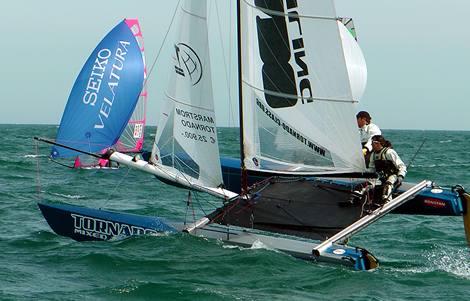
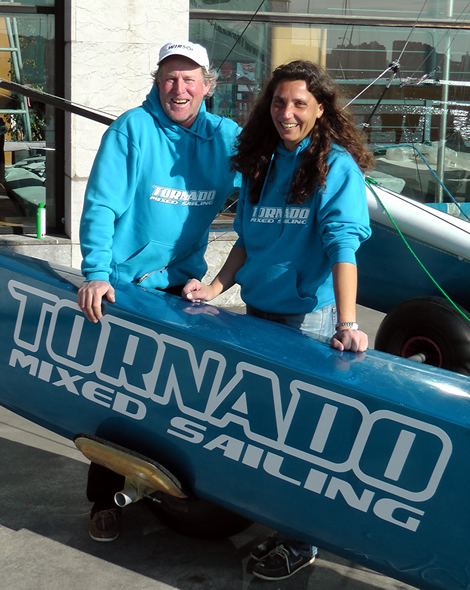
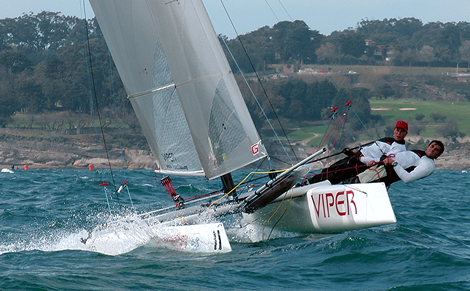
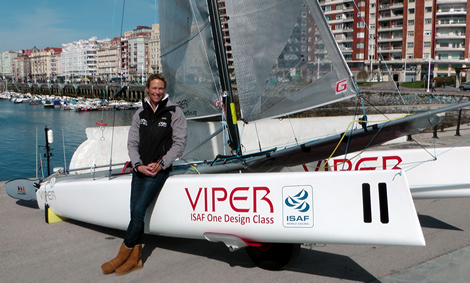
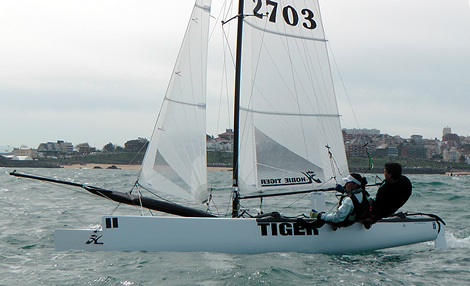
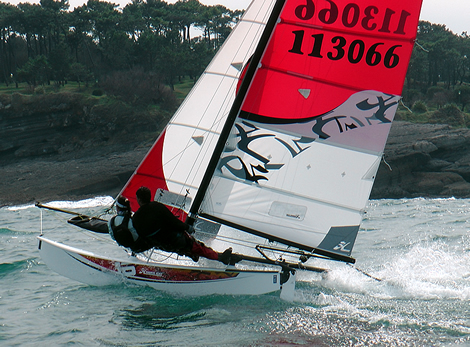
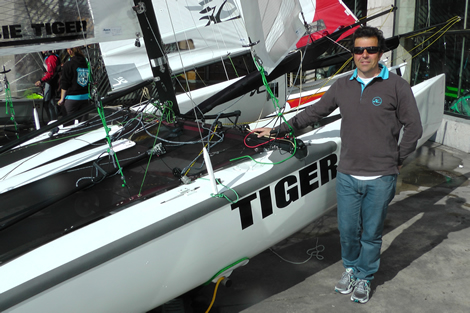
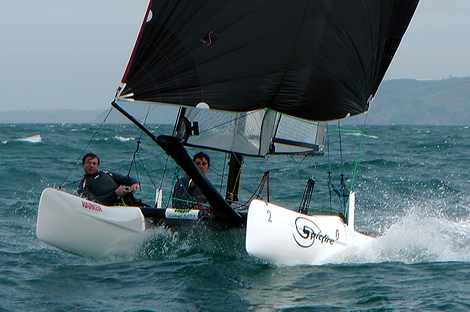
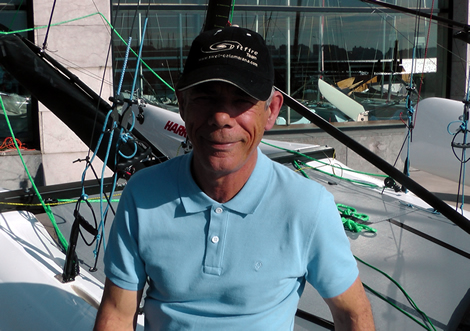








Latest Comments
Add a comment - Members log in